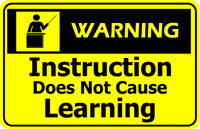I’ve just completed a very strange experience with a client. Well, she wasn’t actually a client — that would suppose that there had been an exchange of funds for services. In this case, there were  many promises of funds, but none ever showed up. It’s not the first time that’s happened to me, and I’m sure it won’t be the last. And it’s not even the biggest lie I’ve ever been told — there was Santa Claus, the Easter Bunny, and the Federal Reserve.
many promises of funds, but none ever showed up. It’s not the first time that’s happened to me, and I’m sure it won’t be the last. And it’s not even the biggest lie I’ve ever been told — there was Santa Claus, the Easter Bunny, and the Federal Reserve.
No, in this case, there was just a string of phone calls and emails about the bright future I would have if I just “trusted” her. If I bought a plane ticket to her client site with my own money, if I started work without a deposit, if I kept revising my proposal over and over and over without ever getting a dime from her. I wouldn’t pony up the money for the plane ticket (not my first time at the rodeo) but I did buy her book, read up on her theories, prepped for a phone conference, participated in more calls and email, and generally wasted hours I’ll never get back.
(My wife, who’s the financial brains in the family, thought I was a fool. From the start she pegged this one for somebody who’d never pay up. But I’m a Minnesotan — our word is our bond, and if you say you’re gonna do something, you do it. And if you sign a freakin’ contract? Done deal, Bubba.)
This went on for three weeks. Finally, I called a halt and said unless she paid the deposit in the contract that she had signed — nothing more would happen.
She said she’d pay if I signed an NDA. Well, that’s pretty common, so I said sure. The agreement was if I signed the NDA she’d send the deposit via return mail. What’s the first clause in her NDA? That I never, ever disclose to anyone outside her team that I participated in the development and facilitation of a public event for 50 learning professionals. Huh? Was I going to wear a hood? I signed, but asked in the return email if she wanted to discuss exactly how this would work.
 Suddenly, I was being unreasonable. We needed to talk. She had a partner who had to be consulted — we might even have to “start over from zero.” Ruh roh, Scooby. The next morning, I had an angry email in the inbox telling me the contract was “canceled” — and “since you haven’t done any work, I don’t owe you anything.”
Suddenly, I was being unreasonable. We needed to talk. She had a partner who had to be consulted — we might even have to “start over from zero.” Ruh roh, Scooby. The next morning, I had an angry email in the inbox telling me the contract was “canceled” — and “since you haven’t done any work, I don’t owe you anything.”
I pointed her to the cancellation clause on my website, common to most freelancers. It says that if I can re-sell the time, I’ll refund your deposit. But my time is all I have to sell, and I’ve already told others I’m unavailable.
Is This A Teachable Moment?
Well, on the one hand, I suppose it should be. I saw right away that this person was pretty emotionally unstable. I’d known her for years — she’d actually been my employer for a bit quite a while back. And I don’t remember any of this kind of stuff. But now she kept changing her mind, spent hours trying to decide on spending $400 on an airfare, continually promised to send a check that never materialized, ignored emails — not at all the kind of behavior that gives you confidence in a professional relationship.
Maybe this is just a difficult time in her life. Maybe there are personal, physical or professional pressures on her right now that are causing this kind of erratic behavior. (I went through menopause with my wife of 14 years, and, at times, she was nuttier than I am normally.) Maybe the stress of starting a new company and striking out in a new direction have overwhelmed her — and somewhere down the road things would even out.
Twenty years ago, I’d be shouting “lawsuit” and bringing in the lawyers and enforcing every recourse that my contract entitles me to. Now, a little older and wiser, I just feel sad that people don’t realize that the learning world is a pretty small pond and that the ripples reach from edge to edge.
 Her argument is quite elegant. If I may distill it, she feels that using Social Media tools only behind your firewall (not allowing employees to connect outside the company) is short-sighted. And that their real value is the cross-pollination and connection that comes from engaging across a discipline, around the world, and to people who see things in vastly different ways.
Her argument is quite elegant. If I may distill it, she feels that using Social Media tools only behind your firewall (not allowing employees to connect outside the company) is short-sighted. And that their real value is the cross-pollination and connection that comes from engaging across a discipline, around the world, and to people who see things in vastly different ways. Yeah, part of getting sessions accepted is a catchy title — but I really believe that most everything we’ve taught our students about content in their formal educational history is wrong. How we design it, how we deploy it, how they interact with it and how we judge if they’ve taken it in successfully.
Yeah, part of getting sessions accepted is a catchy title — but I really believe that most everything we’ve taught our students about content in their formal educational history is wrong. How we design it, how we deploy it, how they interact with it and how we judge if they’ve taken it in successfully. You wouldn’t think of dental work and social media, but he’s done great work in getting a pretty stodgy group to use some really neat tools — and I ran across a
You wouldn’t think of dental work and social media, but he’s done great work in getting a pretty stodgy group to use some really neat tools — and I ran across a 
We try to run from or eradicate that which we do not understand. If we can’t kill it, we try to control it and limit the access of others.
Probably true with the first cave-person who found fire. Still true in corporate America today. I have to admit that I, personally, am actually getting a little tired of having this discussion with potential clients and people who ask for advice.
I want to just say “Whatever” and move on to someone who’s open to new ideas and things that might help them. (Kind of a lifeboat drill — if I’ve only got so many years left, do I spend them arguing with people about the VALUE of parachutes or just HAND OUT parachutes to as many people as possible before the crash?)
It’s actually kind of exhausting. Like trying to convince my mom that “unlimited long-distance” actually meant she could talk to me as long and as often as she liked.
Never won that one, either.
So what do you think? Do you want a parachute, or should we keep talking about the nuts and the in-flight movie?
.